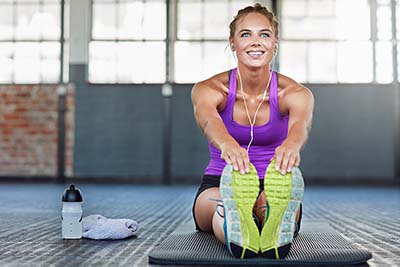Why You Get Muscle Cramps & How to Avoid Them
May 24, 2017
Maybe it’s the end of a long, tiring day, or in the middle of a hard work out, or worst of all, when you’re out on the field or competing in a race… muscle cramps can really shut you down.
While they’re not uncommon, you want to avoid them. Aside from the obvious pain, these spasms can cost you your performance, or even your sleep, depending on when they occur. Because cramps seem to come on suddenly without warning, whether it be a stitch in your side while you’re running, or a “charley horse” in the middle of the night, prevention is ideal.
You might have noticed certain areas are most affected, including your calves, hamstrings, feet and abs. Not only is there is a long list of possible reasons for cramps, more than one factor could be to blame for yours. These include dehydration, electrolyte depletion or mineral deficiencies; circulation, flexibility or alignment issues; and overexertion or premature fatigue.
While there’s no conclusive evidence on one main cause of cramping, there are plenty of clues about when they appear, why, and how we can avoid them. Here are some ideas for preventing and treating muscle cramps.
Preventing Cramps
- Drink plenty of water. Dehydration can not only be a cause of abdominal cramps, it’s been shown to be a leading cause of muscle spasms, too. You can prevent the onset of cramps in many instances by avoiding dehydration—which is why your trainers and coaches have always reminded you to get some water during workouts and games.
- Replenish electrolytes. Electrolytes are chemical (mineral) elements in your body that keep your muscles firing, the most famous of these include potassium, sodium and calcium. Low levels could lead to more likelihood of cramping—bananas, sweet potatoes and sports drinks are all possible antidotes to keep that chemistry in balance.
- Try a vitamin/mineral supplement. A variety of studies have suggested that the right levels of magnesium, zinc, and vitamins B, D, and E could possibly reduce the chance of getting a muscle cramp and/or decrease its severity.
- Keep it moving. Circulation of blood/oxygen along with the right amount of stimulation for our nerves, can help prevent cramps from occurring in a workout. Both during rest periods and for a warm-up, move around, bounce up and down, shake your limbs and breathe deep. Maybe you’ve seen this technique practiced by swimmers who cannot afford a spasm during a meet.
Treat Cramps
- Have a stretch. When you’re moving through or holding a position that’s a challenge, or straining to stay balanced or extended, you can experience a cramp as your muscle seizes up under the pressure. Toe and foot cramps are common in Pilates and yoga classes for this reason. For treatment, immediately start pulling back on your toes, massaging your hamstring, or stretching your ankle to release your calf muscles and increase circulation.
- Release the tension. Another solution for chronic cramping is myofascial release and/or recovery massage. Try rolling the affected area on a tennis ball, frozen water bottle or foam roller. If you’re in serious training, give yourself the gift of massage to help you with all important recovery and release of tight or overworked muscles. Click here to sign up for a free hydromassage session or stop by the spa desk at your XSport Fitness club.
- Know your limits. Your muscle loses reflex control as it gets tired—in other words, it may keep firing instead of relaxing like it’s supposed to, and those overly-ambitious contractions can cause cramps…even hours after your workout. If it’s happening to you, reconsider your training intensity, because you might be pushing too hard.
- Take a break. It’s simple, but effective—stop working when you’re hit with a spasm. Cramps can become worse when you try to push through them. Rest, hydrate, stretch.